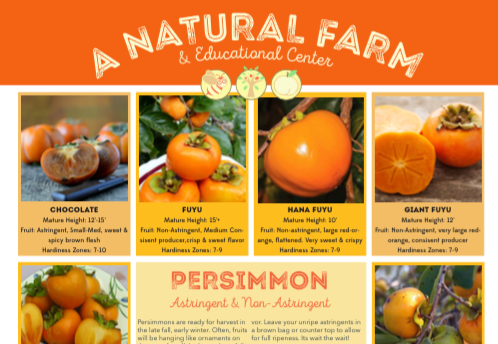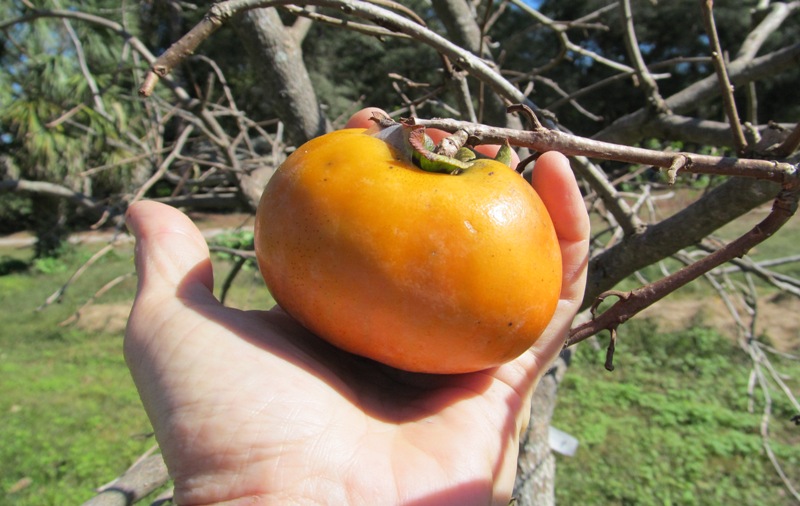'Diospyros kakI'
Astringent vs. Non-Astringent
Astringent fruits must be overly ripe to achieve sweetness and edibility. Softening & astringency removal can be done by allowing fruits to ripen in a brown bag, on the counter top, freezing or drying the fruits. Non-astringent fruits can be eaten firm for a crisp texture.
Non-astringent varieties seem to do better in North/Central Fla, while astringent varieties better in South Fla.
Persimmon Comparsion & Informational Poster for Astringent and Non-Astringent types.
Chocolate (ASTRINGENT)
Small to medium size oblong fruit with bright red skin. Sweet, spicy brown flesh with superb flavor.
USDA Hardiness Zones: 7-10
Chill Hours:
Deciduous/Evergreen: Deciduous
Plant Type: Perennial
Pollinator: Self-Fertile
Blooming Season: Spring
Ripening Season: October-November
Years to Bear Fruit/Edible Qualities: All grafted persimmon trees will be fruit the same year. Non-astringent variety, fruits are edible even when unripe
Climax Height & Spread: 12-15' high
Cold Tolerance:
Light Requirements: Full Sun for more fruits
Drought Tolerance/Watering Requimrents:
Soil & Site Requirements: Apply organic fertilizer 3 times per year by spreading evenly below the tree canopy"
Fuyu (NON-ASTRINGENT)
The most popular of all the persimmons we grow. A consistent producer of medium-sized (41/2 - 6 ounce fruit). The fruit is crisp, sweet and mild and usually starts ripening around the first week of October and continues through mid-November. The trees are vigorous growers that can reach a height of 15 feet.
USDA Hardiness Zones: 7-9
Chill Hours: -
Deciduous/Evergreen: Deciduous
Plant Type: Perennial
Pollinator: Self-Fertile
Blooming Season: Spring
Ripening Season: October-November
Years to Bear Fruit/Edible Qualities: All grafted persimmon trees will be fruit the same year. Non-astringent variety, fruits are edible even when unripe
Climax Height & Spread: 15' high
Cold Tolerance: Dormant during winter months
Light Requirements: Full Sun for more fruits
Drought Tolerance/Watering Requimrents: Newly planted trees should be watered two-three times per week during droughts, water sparlingly during winter.
Soil & Site Requirements: Apply organic fertilizer 3 times per year by spreading evenly below the tree canopy"
Hana Fuyu (NON-ASTRINGENT)
A large reddish-orange fruit that is squarish (4-lobed) and slightly flattened. Very sweet and crispy. Shorter variety of persimmon growing to only 10' tall.
USDA Hardiness Zones: 7-9
Chill Hours: -
Deciduous/Evergreen: Deciduous
Plant Type: Perennial
Pollinator: Self-Fertile
Blooming Season: Spring
Ripening Season: Mid-October
Years to Bear Fruit/Edible Qualities: All grafted persimmon trees will be fruit the same year. Non-astringent variety, fruits are edible even when unripe
Climax Height & Spread: 10' high
Cold Tolerance: Dormant during winter months
Light Requirements: Full Sun for more fruits
Drought Tolerance/Watering Requimrents: Newly planted trees should be watered two-three times per week during droughts, water sparlingly during winter.
Soil & Site Requirements: Apply organic fertilizer 3 times per year by spreading evenly below the tree canopy"
Giant Fuyu (NON-ASTRINGENT)
Very large reddish-orange fruit. Tree is vigorous but only grows to about 12 feet. It is a dependable bearer. Ripens late September and October.
USDA Hardiness Zones: 7-9
Chill Hours: -
Deciduous/Evergreen: Deciduous
Plant Type: Perennial
Pollinator: Self-Fertile
Blooming Season: Spring
Ripening Season: September-October
Years to Bear Fruit/Edible Qualities: All grafted persimmon trees will be fruit the same year. Non-astringent variety, fruits are edible even when unripe
Climax Height & Spread: 12' high
Cold Tolerance: Dormant during winter months
Light Requirements: Full Sun for more fruits
Drought Tolerance/Watering Requimrents: Newly planted trees should be watered two-three times per week during droughts, water sparlingly during winter.
Soil & Site Requirements: Apply organic fertilizer 3 times per year by spreading evenly below the tree canopy"
Giombo (ASTRINGENT)
The fruit of Giombo is large - much like the shape of the Hachiya, yet the Fruit is a smooth texture and very sweet much like the Saijo persimmon. Tree will grow more than 15 feet.
USDA Hardiness Zones: 7-9
Chill Hours: -
Deciduous/Evergreen: Deciduous
Plant Type: Perennial
Pollinator: Self-Fertile
Blooming Season: Spring
Ripening Season: October-November
Years to Bear Fruit/Edible Qualities: All grafted persimmon trees will be fruit the same year. Astringent variety, fruits are best eaten when overly ripe
Climax Height & Spread: 15'+ high
Cold Tolerance: Dormant during winter months
Light Requirements: Full Sun for more fruits
Drought Tolerance/Watering Requimrents: Newly planted trees should be watered two-three times per week during droughts, water sparlingly during winter.
Soil & Site Requirements: Apply organic fertilizer 3 times per year by spreading evenly below the tree canopy"
Great Wall (Astringent)
Bred to withstand the harsh winters of China. Most oranmental variety available. Fruit is tomato shaped, sunset orange with thick full flavor that is sweetest when overly ripe.
USDA Hardiness Zones: 6-9
Chill Hours: -
Deciduous/Evergreen: Deciduous
Plant Type: Perennial
Pollinator: Self-Fertile
Blooming Season: Spring
Ripening Season: September-October
Years to Bear Fruit/Edible Qualities: All grafted persimmon trees will be fruit the same year. Astringent variety, fruits are best eaten when overly ripe
Climax Height & Spread: 15' high
Cold Tolerance: Dormant during winter months
Light Requirements: Full Sun for more fruits
Drought Tolerance/Watering Requimrents: Newly planted trees should be watered two-three times per week during droughts, water sparlingly during winter.
Soil & Site Requirements: Apply organic fertilizer 3 times per year by spreading evenly below the tree canopy"
Hachiya (ASTRINGENT)
Hachiya bears fruit that is rated as one of the best in the world for flavor and quality. The fruit have a jelly-like consistency, sweet & spicy flavor and are probably the most popular astringent persimmon on the market. The fruit is large, deep red that can weigh a pound or more.
USDA Hardiness Zones: 7-9
Chill Hours: -
Deciduous/Evergreen: Deciduous
Plant Type: Perennial
Pollinator: Self-Fertile
Blooming Season: Spring
Ripening Season: Mid October-Late November
Years to Bear Fruit/Edible Qualities: All grafted persimmon trees will be fruit the same year. Astringent variety, fruits are best eaten when overly ripe
Climax Height & Spread: 15'+ high
Cold Tolerance: Dormant during winter months
Light Requirements: Full Sun for more fruits
Drought Tolerance/Watering Requimrents: Newly planted trees should be watered two-three times per week during droughts, water sparlingly during winter.
Soil & Site Requirements: Apply organic fertilizer 3 times per year by spreading evenly below the tree canopy"
Ichi-Ki-Kei-Jiro (NON-ASTRINGENT)
Semi-Dwarfing. Hardest Asian Persimmon up to zone 6. Bountiful harvest with squarish, 4 lobed & slightly flattened Medium-Large, non-astringent fruit (sweet even when picked firm like an apple). Fruit is round to oblate. Annual Producer.
USDA Hardiness Zones: 6-9
Chill Hours: -
Deciduous/Evergreen: Deciduous
Plant Type: Perennial
Pollinator: Self-Fertile
Blooming Season: Spring
Ripening Season: September-October
Years to Bear Fruit/Edible Qualities: All grafted persimmon trees will be fruit the same year. Non-astringent variety, fruits are edible even when unripe
Climax Height & Spread: 8'-10' high
Cold Tolerance: Dormant during winter months
Light Requirements: Full Sun for more fruits
Drought Tolerance/Watering Requimrents: Newly planted trees should be watered two-three times per week during droughts, water sparlingly during winter.
Soil & Site Requirements: Apply organic fertilizer 3 times per year by spreading evenly below the tree canopy"
Jiro (NON-ASTRINGENT)
Consider one of the more cold-hardy non-astringent types. Fruit is large, 4-lobed,slightly flattened and a beautiful orange red color. Trees are more upright compared to other Jiro types.
USDA Hardiness Zones: 6-9
Chill Hours:
Deciduous/Evergreen: Deciduous
Plant Type: Perennial
Pollinator: Self-Fertile
Blooming Season: Spring
Ripening Season: October-November
Years to Bear Fruit/Edible Qualities: All grafted persimmon trees will be fruit the same year. Non-astringent variety, fruits are edible even when unripe
Climax Height & Spread: 15'+ high
Cold Tolerance:
Light Requirements: Full Sun for more fruits
Drought Tolerance/Watering Requimrents:
Soil & Site Requirements: Apply organic fertilizer 3 times per year by spreading evenly below the tree canopy"
Matsumoto Fuyu (NON-ASTRINGENT)
Very much like the Fuyu except it ripens about two weeks ahead of Fuyu, usually about mid-September. Consistently heavy bearer.
USDA Hardiness Zones: 7-9
Chill Hours: -
Deciduous/Evergreen: Deciduous
Plant Type: Perennial
Pollinator: Self-Fertile
Blooming Season: Spring
Ripening Season: Ripens late October-December
Years to Bear Fruit/Edible Qualities: All grafted persimmon trees will be fruit the same year. Non-astringent variety, fruits are edible even when unripe
Climax Height & Spread: 25'+ high
Cold Tolerance: Dormant during winter months
Light Requirements: Full Sun for more fruits
Drought Tolerance/Watering Requimrents: Newly planted trees should be watered two-three times per week during droughts, water sparlingly during winter.
Soil & Site Requirements: Apply organic fertilizer 3 times per year by spreading evenly below the tree canopy"
Maekawa-Jiro (Non-Astringent)
One of the best tasting persimmons. Fruit is large, 4 lobed, slightly flattened - similar to other Jiro types.
USDA Hardiness Zones: 6-9
Chill Hours:
Deciduous/Evergreen: Deciduous
Plant Type: Perennial
Pollinator: Self-Fertile
Blooming Season: Spring
Ripening Season: Mid October-Late November
Years to Bear Fruit/Edible Qualities: All grafted persimmon trees will be fruit the same year. Astringent variety, fruits are best eaten when overly ripe
Climax Height & Spread: 12' high
Cold Tolerance:
Light Requirements: Full Sun for more fruits
Drought Tolerance/Watering Requimrents:
Soil & Site Requirements: Apply organic fertilizer 3 times per year by spreading evenly below the tree canopy"
Nikita's Gift (Astringent)
Cross between American & Russian Persimmon with similar qualities of an Asain. Fruits are 2-3inches reddish orange and exceptionally sweet when ripe. Hardiest Persimmon available.
USDA Hardiness Zones: 5-8
Chill Hours: -
Deciduous/Evergreen: Deciduous
Plant Type: Perennial
Pollinator: Self-Fertile
Blooming Season: Spring
Ripening Season: Ripens early October-November
Years to Bear Fruit/Edible Qualities: All grafted persimmon trees will be fruit the same year. Astringent variety, fruits are best eaten when overly ripe
Climax Height & Spread: 12' high
Cold Tolerance: Dormant during winter
Light Requirements: Full Sun for more fruits
Drought Tolerance/Watering Requimrents: Newly planted trees should be watered two-three times per week during droughts, water sparlingly during winter.
Soil & Site Requirements: Apply organic fertilizer 3 times per year by spreading evenly below the tree canopy"
Saijo (ASTRINGENT)
Saijo fruits are oblong orange and very sweet. Saijo persimmon trees are vigorous, upright growers that can grow to 20-25 feet.
USDA Hardiness Zones: 7-9
Chill Hours: -
Deciduous/Evergreen: Deciduous
Plant Type: Perennial
Pollinator: Self-Fertile
Blooming Season: Spring
Ripening Season: Mid-September through Mid-October
Years to Bear Fruit/Edible Qualities: All grafted persimmon trees will be fruit the same year. Astringent variety, fruits are best eaten when overly ripe
Climax Height & Spread: 20'-25' high
Cold Tolerance: Dormant during winter months
Light Requirements: Full Sun for more fruits
Drought Tolerance/Watering Requimrents: Newly planted trees should be watered two-three times per week during droughts, water sparlingly during winter.
Soil & Site Requirements: Apply organic fertilizer 3 times per year by spreading evenly below the tree canopy"
Tanenashi Fuyu (ASTRINGENT)
Tanenashi trees are medium-sized (12-15') vigorous growers that consistently produce a good crop of medium to large cone-shaped orange –red fruit. The flesh is yellow when ripe and has a dry texture, which some people prefer. Probably has the best name-recognition of all astringents.
USDA Hardiness Zones: 7-9
Chill Hours: -
Deciduous/Evergreen: Deciduous
Plant Type: Perennial
Pollinator: Self-Fertile
Blooming Season: Spring
Ripening Season: Ripens early October-November
Years to Bear Fruit/Edible Qualities: All grafted persimmon trees will be fruit the same year. Astringent variety, fruits are best eaten when overly ripe
Climax Height & Spread: 12'-15' high
Cold Tolerance: Dormant during winter
Light Requirements: Full Sun for more fruits
Drought Tolerance/Watering Requimrents: Newly planted trees should be watered two-three times per week during droughts, water sparlingly during winter.
Soil & Site Requirements: Apply organic fertilizer 3 times per year by spreading evenly below the tree canopy"















